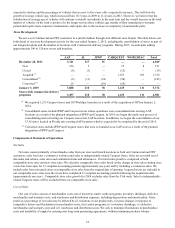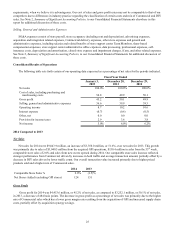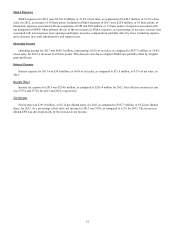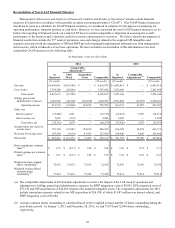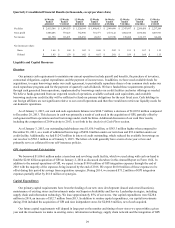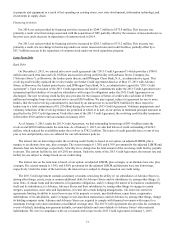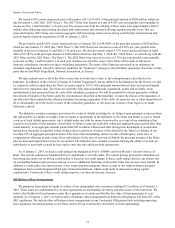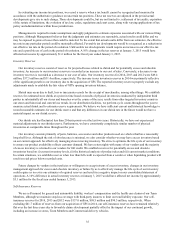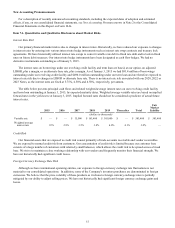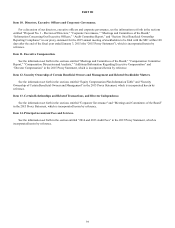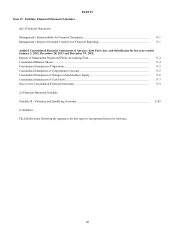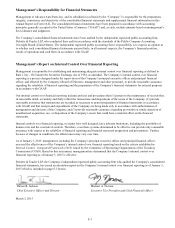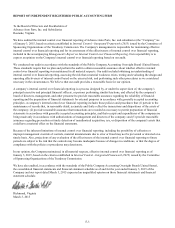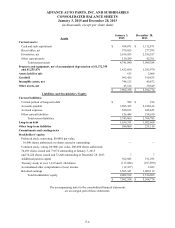Advance Auto Parts 2014 Annual Report Download - page 41
Download and view the complete annual report
Please find page 41 of the 2014 Advance Auto Parts annual report below. You can navigate through the pages in the report by either clicking on the pages listed below, or by using the keyword search tool below to find specific information within the annual report.34
Critical Accounting Policies
Our financial statements have been prepared in accordance with accounting policies generally accepted in the United
States of America. Our discussion and analysis of the financial condition and results of operations are based on these financial
statements. The preparation of these financial statements requires the application of accounting policies in addition to certain
estimates and judgments by our management. Our estimates and judgments are based on currently available information,
historical results and other assumptions we believe are reasonable. Actual results could differ materially from these estimates.
The preparation of our financial statements included the following significant estimates and exercise of judgment.
Acquisition Impacts
We acquired GPI on January 2, 2014. The process of integrating GPI with AAP has begun, and we expect the integration to
continue for a few years. We have used various valuation methodologies to estimate the fair value of assets acquired and
liabilities assumed, including using a market participant perspective when applying certain generally accepted valuation
techniques, supplemented with market appraisals where appropriate. Significant judgments and estimates were required in
preparing these fair value estimates. Final decisions about product offerings, brand usage, store conversions and other elements
of the integration plan could be different from current plans. Accordingly, critical accounting policies and estimates such as, but
not limited to, inventory valuation/obsolescence, asset impairments, goodwill and other intangible assets and income taxes may
have additional acquisition-related impacts beyond what is described in the following respective critical accounting policies.
Goodwill and Intangible Assets
We evaluate goodwill and indefinite-lived intangibles for impairment annually as of the first day of our fiscal fourth
quarter or whenever events or changes in circumstances indicate the carrying value of the goodwill or other intangible asset
may not be recoverable. We test for goodwill impairment at the reporting unit level. As of January 3, 2015, the vast majority of
our goodwill balance was allocated to three of our five reporting units. Our detailed impairment testing involves comparing the
fair value of each reporting unit to its carrying value, including goodwill. If the fair value exceeds carrying value, we conclude
that no goodwill impairment has occurred. If the carrying value of the reporting unit exceeds its fair value, a second step is
required to measure possible goodwill impairment loss. We complete our impairment evaluation by combining information
from our internal valuation analyses, considering other publicly available market information and using an independent
valuation firm.
We determine fair value using widely accepted valuation techniques, including discounted cash flows and market multiple
analyses. These types of analyses require management to make assumptions as a marketplace participant would and to apply
judgment to estimate industry economic factors and the profitability of future business strategies of our company and our
reporting units. These assumptions and estimates are a major component of the derived fair value of our reporting units.
Critical assumptions include projected sales growth, gross profit rates, SG&A rates, working capital fluctuations, capital
expenditures, discount rates and terminal growth rates.
The carrying value of goodwill was $995.4 million and $199.8 million at January 3, 2015 and December 28, 2013,
respectively. The increase to goodwill in 2014 was primarily due to our acquisition of GPI, and has been allocated between our
Carquest and Worldpac reporting units. For the periods presented, the impairment assessments indicated that the fair values of
each reporting unit exceeded the carrying values of the respective reporting units and therefore no impairment existed. The
margin of calculated fair value over the respective carrying value of our recently acquired reporting units may not be indicative
of the total company because there have been no significant changes in valuation assumptions since the acquisition date. We
have not made any material changes in the accounting methodology we use to assess impairment loss during the past three
fiscal years. We do not believe there is a reasonable likelihood there will be a material change in the future estimates or
assumptions we use to test for impairment losses on goodwill. However, if actual results are not consistent with our estimates
or assumptions, we may be exposed to an impairment charge that could be material.
Income Tax Reserves
The determination of our income tax liabilities is based upon the tax law, codes, regulations, pronouncements and court
cases for the taxing jurisdictions in which we do business. Our income tax returns are periodically examined by those
jurisdictions. These examinations include, among other things, auditing our filing positions, the timing of deductions and
allocation of income among the various jurisdictions. At any particular time, multiple years are subject to examination by
various taxing authorities.


